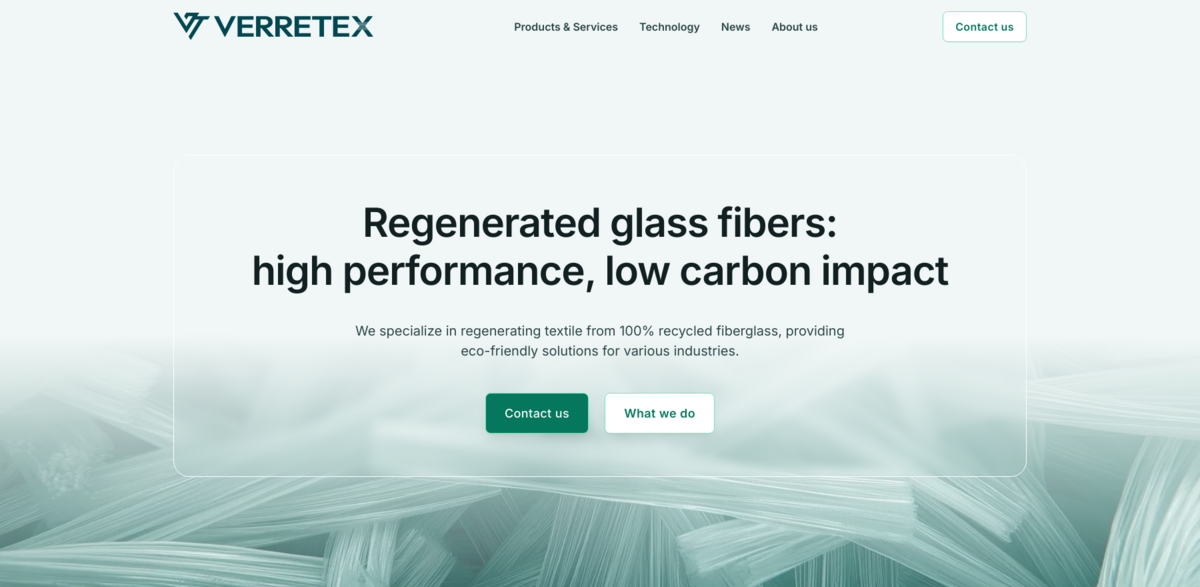What is the Verretex Project?
Verretex is revolutionizing the way glass fibers are handled by regenerating textile from 100% recycled fiberglass. This innovative project transforms waste into high-quality, eco-friendly glass fiber textiles, offering a sustainable alternative to virgin fibers. By upcycling glass fibers recovered from various recycling processes, Verretex creates premium non-woven textiles that serve multiple industries. It’s not just about recycling—it’s about turning waste into value and pioneering a circular economy that benefits both people and the planet.
Main Benefits of Verretex’s Regenerated Glass Fibers
Verretex’s approach brings a bunch of impressive benefits to the table, including:
- Cutting carbon emissions by up to 80% compared to traditional glass fiber production
- Producing high-quality non-woven textiles with virgin-like mechanical properties
- Offering cost-effective solutions that reduce raw material expenses for manufacturers
- Creating a circular value chain by turning composite waste into valuable materials
- Supporting a cleaner environment by conserving natural resources and reducing waste
- Providing custom fiber solutions tailored to specific project needs
- Enabling scalable integration across various production lines and industries
Industries Benefiting from Regenerated Glass Fiber Textiles
Verretex’s regenerated glass fibers find applications across a wide range of sectors. In building and construction, these mats reinforce roofing shingles, wall coverings, and flooring underlayments, boosting durability and moisture resistance. The automotive industry uses them in headliners, insulation panels, underbody shields, and trunk liners to improve sound insulation and thermal management. Marine applications include hulls and decks where strength and water resistance are key. Energy sectors employ these mats in wind turbine blades and industrial plant insulation, enhancing performance and longevity. Electronics benefit from their excellent electrical insulation properties in printed circuit boards, while sports equipment like surfboards and skis gain structural reinforcement and durability.
How Verretex Creates a Circular Economy
At the heart of Verretex’s mission is the commitment to sustainability through upcycling. The project’s proprietary process collects, packages, and transports reclaimed glass fiber using high-density packaging that minimizes fiber degradation. This ensures the fibers maintain their quality before being regenerated into new textiles. By collaborating closely with recycling companies, Verretex offers offtake and upcycling services that make recycling glass fiber composite waste not only possible but profitable. This approach eliminates the costly need to remelt glass fibers, preserving their integrity and value throughout the lifecycle.
Quality and Sustainability in Glass Fiber Regeneration
Verretex’s regenerated glass fiber textiles undergo rigorous testing to meet industry standards and customer expectations. Adjustable areal weights provide versatility, allowing the textiles to adapt to various industrial and sustainability requirements. The result? High-performance, eco-friendly materials that don’t compromise on quality. This dedication to excellence ensures that regenerated fibers can confidently replace virgin fibers in demanding applications, all while supporting a more sustainable future.
Project Impact on Sustainable Development Goals (SDGs)
- SDG 9: Industry, Innovation, and Infrastructure – fostering sustainable industrialization through innovative recycling technologies
- SDG 11: Sustainable Cities and Communities – contributing to sustainable building materials and construction practices
- SDG 12: Responsible Consumption and Production – promoting circular economy principles and waste reduction
- SDG 13: Climate Action – significantly reducing carbon emissions associated with glass fiber production
- SDG 14: Life Below Water – minimizing marine pollution by reducing composite waste
- SDG 15: Life on Land – conserving natural resources and reducing landfill use
Supporting Recycling Companies and Industry Partners
Verretex doesn’t just stop at producing regenerated fibers—it actively supports recycling companies by providing higher-value solutions for glass fiber composite waste. Through partnerships with industrial players, Verretex ensures that all processed waste is safe to recover and handle, facilitating a smooth recycling process. This collaboration helps recycling companies avoid the expensive and quality-degrading step of remelting glass fibers, making the entire chain more efficient and profitable. The project’s expert consultation and custom fiber solutions further assist manufacturers in integrating recycled fibers into their products, driving sustainability across industries.





















